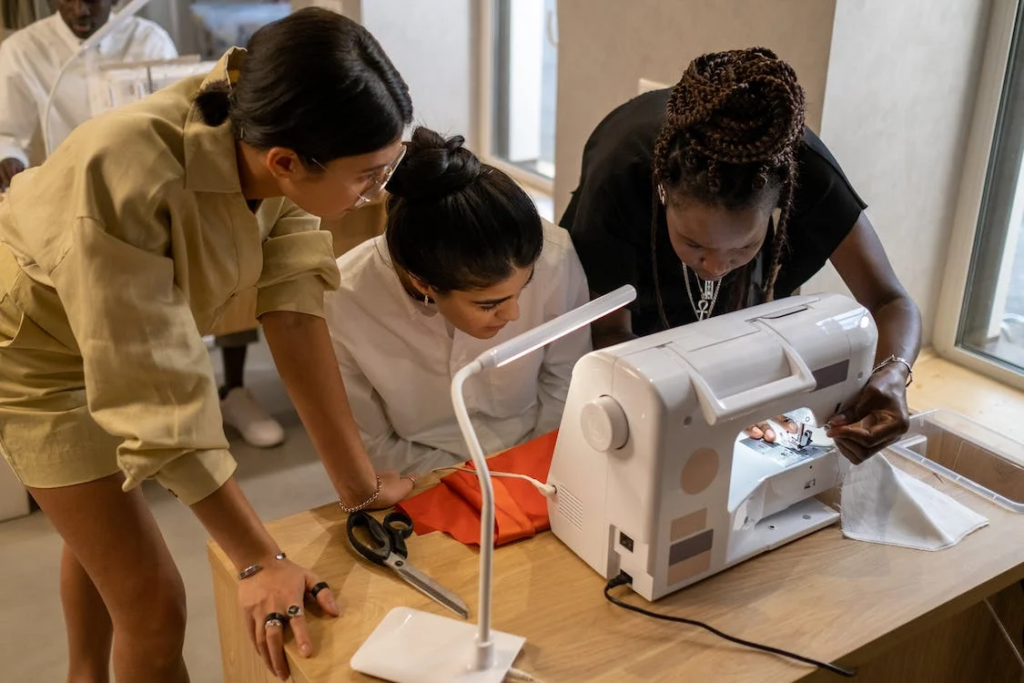In the dynamic realm of fashion designing, talent and creativity are undoubtedly crucial, but without effective marketing strategies, even the most innovative designs can go unnoticed. Whether you’re a budding fashion entrepreneur or a seasoned designer looking to expand your reach, mastering the art of marketing is essential for carving out a successful niche in the industry. This comprehensive guide aims to equip you with the knowledge and tools necessary to elevate your fashion designing business through strategic marketing initiatives.

Fashion is not merely about clothing; it’s a reflection of culture, identity, and expression. As such, the competition within the fashion industry is fierce, with countless designers vying for attention in an increasingly saturated market. To stand out amidst the noise and capture the hearts of your target audience, you need more than just remarkable designs—you need a robust marketing strategy that effectively communicates your brand story and resonates with consumers on a deeper level. This article will delve into various proven techniques and best practices tailored specifically for fashion entrepreneurs, empowering you to navigate the intricacies of marketing your unique vision to the world.
Understanding Your Target Audience
To thrive in the competitive fashion industry, grasping the nuances of your target demographic is paramount. Conducting thorough market research enables you to identify the preferences, behaviors, and aspirations of your potential customers. By analyzing demographic data, such as age, gender, and location, you can tailor your designs and marketing efforts to resonate with your audience on a deeper level.
Furthermore, delving into psycho graphic insights allows you to understand the values, interests, and lifestyles of your target audience. By uncovering their motivations and aspirations, you can develop products and messaging that align with their desires, fostering a deeper connection and loyalty to your brand. Through continuous audience analysis and feedback, you can adapt and refine your strategies to meet the evolving needs of your customers, ensuring long-term success in the fashion designing business.
Building Your Brand Identity
Crafting a distinctive brand identity is essential for fashion businesses seeking to stand out in a crowded market. Start by developing a compelling brand story that encapsulates your unique vision, values, and journey. This narrative serves as the foundation upon which you can build a cohesive brand image that resonates with your target audience.
A visually appealing brand logo and consistent visual identity are key elements in conveying your brand’s essence. Invest in Professional design services to create a logo that reflects your brand’s personality and resonates with your audience. Consistency across all brand touch points, from your website to social media profiles, reinforces brand recognition and fosters trust among consumers. By prioritizing brand authenticity and consistency, you can cultivate a strong and memorable brand identity that sets your fashion business apart from the competition.
Creating Compelling Content
In today’s digital landscape, crafting captivating content is crucial for fashion brands to engage their audience effectively. One powerful tool for storytelling is the use of online videos, and leveraging an online video editor can significantly enhance the quality of your content. With features like easy editing and professional effects, online video editors streamline the process of creating visually appealing videos to showcase your fashion designs and brand narrative.
By incorporating an online video editor into your content creation strategy, you gain the flexibility to produce various types of videos, from product showcases to behind-the-scenes glimpses of your creative process. This versatility allows you to tailor your content to different platforms and target demographics, maximizing your reach and engagement.
Leveraging Social Media Marketing
Social media has become a cornerstone of marketing strategy for fashion businesses, offering unparalleled opportunities for brand exposure and engagement. By strategically utilizing platforms like Instagram, Facebook, and Tik-Tok, fashion entrepreneurs can connect with their target audience on a more personal level, showcasing their designs, sharing behind-the-scenes glimpses, and fostering a sense of community. With features like Instagram Stories and Reels, brands can leverage interactive content formats to captivate their audience and drive meaningful interactions.
Moreover, social media platforms offer powerful targeting options, allowing fashion businesses to reach specific demographics based on factors like age, location, and interests. By tailoring content to resonate with different segments of their audience, brands can maximize engagement and conversion rates. Additionally, incorporating user-generated content and influencer partnerships into social media marketing strategies can further amplify brand reach and credibility.
Search Engine Optimization Strategies
In the fast-paced world of fashion, implementing effective SEO strategies is crucial for ensuring visibility and attracting potential customers. By conducting keyword research and optimizing website content with relevant terms like “fashion design” and “clothing trends,” fashion businesses can improve their search engine rankings and drive organic traffic. Additionally, optimizing meta tags, headers, and image alt texts enhances website accessibility and readability, further boosting SEO performance.
Moreover, building high-quality back links from reputable fashion websites and industry influencers can significantly improve a fashion business’s authority and credibility in the eyes of search engines. By regularly updating website content and incorporating fresh, relevant keywords, brands can stay ahead of evolving search engine algorithms and maintain a competitive edge. With a strategic approach to SEO, fashion businesses can increase their online visibility, attract targeted traffic, and ultimately, drive conversions and sales.
Influencer Marketing
In the realm of fashion, influencer marketing has emerged as a powerful strategy for brands to connect with their target audience authentically. Collaborating with influencers who have a strong presence in the fashion niche allows brands to tap into their loyal follower base and leverage their credibility and influence. By partnering with influencers whose style and values align with their brand, fashion businesses can effectively reach a wider audience and drive engagement.
Furthermore, influencer marketing offers opportunities for brands to showcase their products in an organic and relatable way, as influencers integrate them seamlessly into their content. Whether it’s featuring a fashion brand in a styled photoshoot or sharing a personal review, influencer endorsements carry significant weight and can influence purchase decisions. Additionally, tracking key performance indicators such as engagement rates, click-through rates, and conversion metrics allows brands to measure the effectiveness of their influencer partnerships and optimize future campaigns for maximum impact.
Email Marketing Campaigns
Email marketing remains a potent tool for fashion businesses to engage with their audience and drive sales. Crafting compelling newsletters that showcase new arrivals, exclusive promotions, and behind-the-scenes content can captivate subscribers and keep them informed about the latest trends. Personalizing email content based on customer preferences and purchase history enhances relevance and increases the likelihood of conversions.
Segmenting email lists allows fashion brands to tailor messages to specific audience segments, delivering targeted content that resonates with recipients. Moreover, incorporating eye-catching visuals and clear call-to-action buttons encourages recipients to take desired actions, such as visiting the website or making a purchase. By analyzing email performance metrics like open rates and click-through rates, brands can refine their email marketing strategies and deliver content that consistently delivers value to subscribers.
Collaborations and Partnerships
Forming strategic collaborations and partnerships is a potent strategy for fashion businesses to expand their reach and foster brand growth. By teaming up with complementary brands or influencers, fashion entrepreneurs can tap into new audiences and amplify their brand message. Collaborative projects, such as co-branded collections or exclusive events, not only generate buzz but also provide opportunities for cross-promotion and shared resources.
Furthermore, partnerships with industry insiders, such as fashion bloggers or stylists, can lend credibility and authenticity to a brand’s image. Leveraging their expertise and influence allows fashion businesses to gain exposure to their followers and establish trust with potential customers. By selecting partners whose values align with their own, brands can ensure that collaborations resonate with their target audience and drive meaningful engagement and conversions.
Analyzing and Measuring Results
In the competitive landscape of fashion, analyzing and measuring marketing efforts is essential for staying ahead of the curve. Utilizing key performance indicators (KPIs) such as website traffic, engagement rates, and conversion metrics allows fashion businesses to gauge the effectiveness of their marketing strategies. By tracking these metrics over time, brands can identify trends, pinpoint areas for improvement, and make data-driven decisions to optimize their marketing efforts.
Moreover, leveraging analytics tools like Google Analytics provides invaluable insights into customer behavior and preferences. Understanding which channels and campaigns drive the most traffic and conversions enables brands to allocate resources effectively and focus on initiatives with the highest ROI. Additionally, conducting A/B testing and experimenting with different messaging and visuals allows brands to refine their marketing strategies and tailor content to better resonate with their target audience. Through continuous analysis and optimization, fashion businesses can stay agile and responsive to market dynamics, ensuring long-term success in the industry.
Conclusion
In conclusion, mastering the art of marketing is essential for fashion businesses looking to thrive in today’s competitive landscape. From understanding your target audience to leveraging social media, email marketing, and strategic collaborations, each aspect of the marketing process plays a crucial role in building brand awareness and driving sales. By staying informed about industry trends, continuously analyzing and measuring results, and adapting strategies accordingly, fashion entrepreneurs can navigate the ever-evolving market with confidence. Ultimately, by prioritizing innovation, authenticity, and a customer-centric approach, fashion businesses can carve out a unique niche and establish a lasting presence in the dynamic world of fashion.




